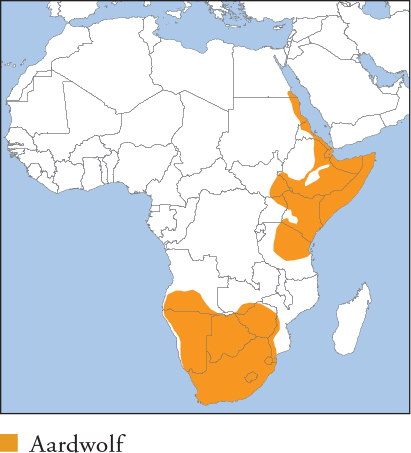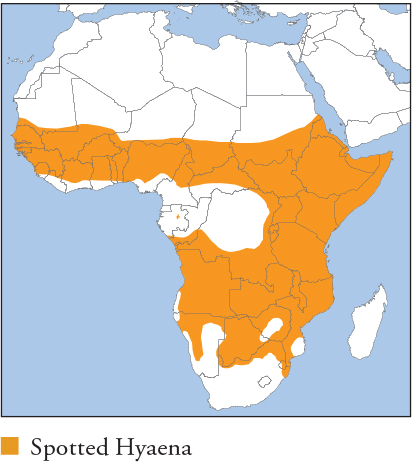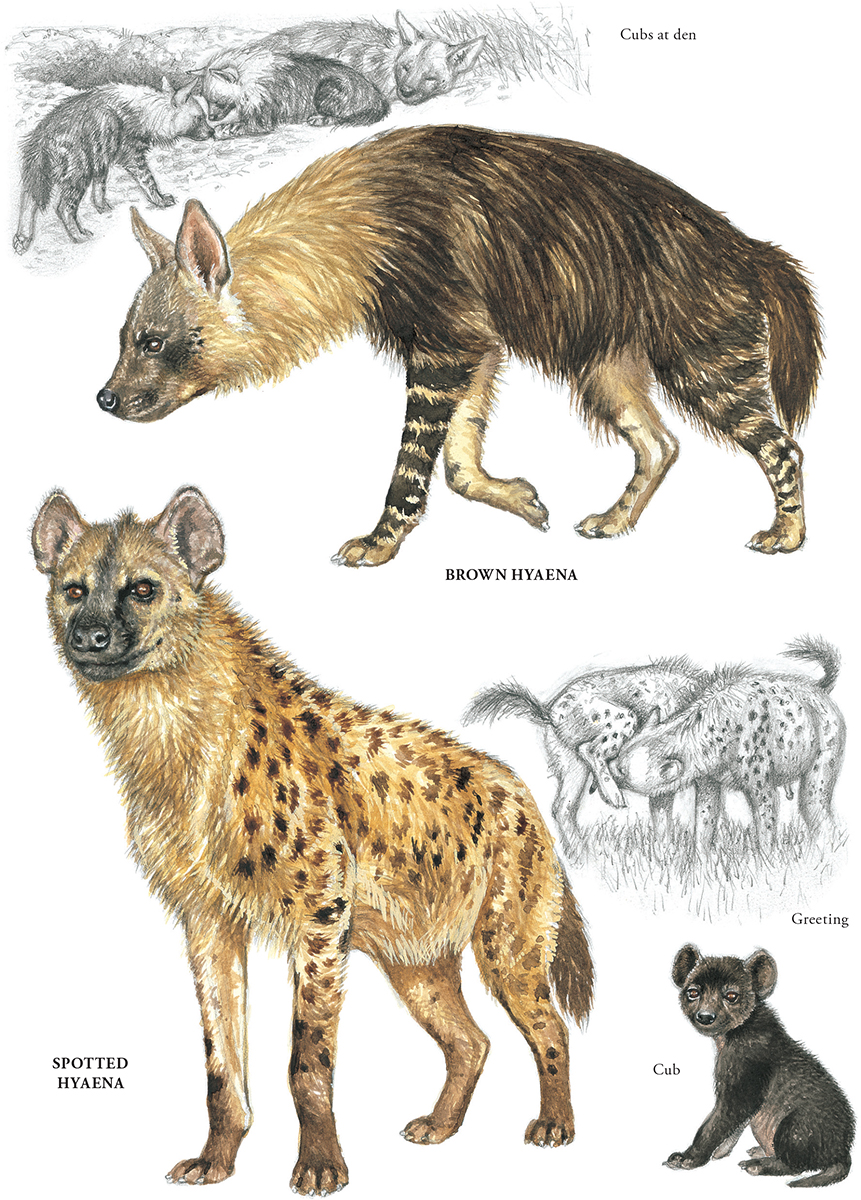
| AARDWOLF Proteles cristata |
HB 55–80cm; T 19–30cm; SH 43–50cm; W 7.7–14kg
Smallest hyaena, superficially resembling Striped Hyaena but half its size and lightly built, with a narrow head and slender black muzzle. Jackal-sized in the field, but can appear much larger by erecting its dorsal mane when threatened. Distribution and Habitat Two disjunct populations in southern and E to NE Africa. Favours open habitat, including semi-desert, grassland and woodland savannah, and does not require standing water, which it obtains from its diet. Avoids true desert, dense woodland and forest. Feeding Ecology Feeds almost exclusively on Snouted Harvester Termites, lapping up as many as 300,000 (1.2kg) per night from dense feeding processions on the soil surface. Very occasionally and opportunistically consumes beetles, ants, sun spiders and scorpions. Cold winters and high rainfall force Snouted Harvester Termites below ground, driving Aardwolves to switch to less social termite species that require more energy to find and consume. Under winter food stress, adults can lose 25% of their weight and cubs are vulnerable to starvation. Foraging is generally nocturnal, but may shift diurnally in winter. Reflecting the diet, the species has a very long, paddle-shaped tongue, copious sticky saliva and small, almost nonfunctional, peg-like cheek-teeth (it has retained the large canines, which are used for territorial defence and against predators). Does not take livestock or carrion; there is 1 very unusual verified record of an Aardwolf killing 2 captive geese and partially eating one. Social and Spatial Behaviour Monogamous (although extra-pair matings are common) and territorial. Forms breeding pairs that endure for 2–5 years. Pairs cooperatively maintain stable territories, with very frequent scent-marking by both sexes, and share cub-raising duties, chiefly guarding the den against predators. Adults and independent cubs usually forage alone, but family members occasionally congregate at termite colonies. Territories 1–6km2, depending on density of termite colonies. Reproduction and Demography Seasonal. Mating June–July. Cubs born October–December (Eastern Cape, South Africa). Oestrus 3 days; gestation 90 days. Litter size 2–4, exceptionally 5 in captivity. Cubs weaned at 12–16 weeks, by which time they begin to forage alone. Cubs are fully independent at 6–7 months, and most disperse before the following year’s litter is born. MORTALITY Survival is tied to termite abundance; cub mortality is typically around 30%, but rose to 55% during a drought in one study. Adult mortality poorly known. Occasionally killed by all large carnivores, but the chief predator (of cubs) is Black-backed Jackal. LIFESPAN Unknown in the wild, 15 years in captivity. Status and Threats Generally widespread and secure. Snouted Harvester Termites thrive in disturbed grassland habitats, including livestock areas, which are suitable for Aardwolves under enlightened management. Agricultural poisoning (usually for locusts) results in termite die-offs that trigger Aardwolf declines. Despite never eating meat, Aardwolves are erroneously persecuted for livestock losses. Hundreds are killed annually as ‘by-catch’ in jackal-control efforts in southern Africa. CITES Appendix III – Botswana; Red List LC, population trend Stable.

| STRIPED HYAENA Hyaena hyaena |
HB 98–119cm; T 26–47cm; SH 60–74cm; W ♀ 23–34kg, ♂ 26–41kg
The only hyaena whose range extends into Eurasia. Ash- to straw-coloured, with black stripes on the body and legs, and a distinctive black throat patch. Tail typically lacks a black tip. Longest dorsal mane of any hyaena, which is erected defensively and becomes long and luxuriant in northern individuals in winter. Distribution and Habitat W, N and E Africa, the Middle East to the Caucasus, and C Asia to India. Favours open semi-arid habitats with cover, especially dry woodland savannah, dry forest, semi-desert and mountainous terrain to 3,300m. Absent from dense woodland, tropical forest and interiors of true desert. Inhabits modified habitats with cover, including agricultural and peri-urban landscapes, e.g. Casuarina plantations, coastal Odisha, India. Feeding Ecology Principally a scavenger of dead wild and domestic ungulates. Scavenges the remains of kills made by large carnivores, and is often found close to livestock herds looking for dead animals. Hunting ability poorly understood. Reputed to hunt large prey and widely blamed for killing livestock, but there is little evidence for this. Opportunistically catches small mammals and birds, and capable of opening the carapaces of large land turtles and tortoises. Also eats a wide variety of vegetables, fruits and invertebrates; seasonally, these items may surpass carrion in importance in the diet. During mass nesting events of Olive Ridley Turtles, hyaenas are recorded excavating the nests for eggs (Rushikulya sea turtle rookery, India). Raids fruit and vegetable crops in some areas, where it is treated as a pest, e.g. Israel. Typically forages alone, but may congregate loosely at food patches, including refuse dumps. Foraging is mostly nocturnal, especially where it lives close to humans. Provided it is not persecuted, it is sometimes more crepuscular in winter or during overcast and rainy weather. Often brings prey remains back to the den, which is used by many generations, sometimes creating massive bone accumulations. Social and Spatial Behaviour The least-studied hyaena and poorly known. Inhabits an enduring home range, which is scent-marked regularly, but there is little evidence for territorial defence. In C Asia, reportedly forms monogamous breeding pairs that may endure for more than a season; cubs of previous litters sometimes remain with a pair, suggesting helpers (as for canids). In C Kenya, forms ‘proto-social’ groups with 1 female and up to 3 adult males that may or may not be related. Group members occupy a shared range, and meet for social interaction and resting. Range size in C Kenya 36–101km2 (♀s) and 52–115km2 (♂s), with little overlap between females but high overlap among males. Density estimates 2–3/100km2 (E Africa), 8.5/100km2(Negev Desert, Israel). Reproduction and Demography Aseasonal. Oestrus reportedly only 1 day; gestation 90–91 days. Litter size typically 1–4, exceptionally 5 (captivity). Cubs begin to eat meat at around 1 month, but are suckled for 6–12 months. Females are sexually mature at 1 year and may give birth at 15–18 months, but usually first breed at around 24–27 months. MORTALITY Poorly known; 47% of adults in C Kenya survived a further 3 years from when first identified. LIFESPAN Unknown in the wild, 23–24 years in captivity. Status and Threats Although widespread, occurs naturally at low densities and much of its remaining range is fragmented into isolated populations. Often intensely persecuted for its perceived effect on livestock and widespread superstitions related to grave robbing (which occurs), witchcraft and folk medicine. Frequently killed on roads when searching for roadkilled carrion. CITES Appendix III – Pakistan; Red List NT, population trend Decreasing.

Plate 20

| BROWN HYAENA Parahyaena brunnea |
HB 110–136cm; T 18–27cm; SH 71.5–82cm; W ♀ 28–47.5kg, ♂ 35–49.5kg
Medium-sized hyaena covered in coarse, shaggy, dark brown fur that fades to blond on the neck and shoulders. Dark stripes on a light background cover the legs. Males are only slightly larger than females. Distribution and Habitat Endemic to southern Africa. Independent of water and inhabits various arid to semiarid habitats, from open desert to woodland savannah. Can occupy pastoral habitats close to people, e.g. Johannesburg’s outer suburbs. Feeding Ecology Scavenger that feeds mainly on the carcasses of dead mammals. Opportunistically takes small vertebrate prey up to the size of antelope lambs, but kills comprise only 6–16% of the diet. Coastal Namibian individuals live almost exclusively on Cape Fur Seals, which are mostly scavenged, although young pups are actively hunted. Also eats vegetables, fruits, invertebrates, eggs and human refuse. Predation on small livestock occasionally occurs. Foraging is solitary, although it congregates at large carcasses, seal colonies and refuse dumps. Mostly forages at night, but more diurnal in cool conditions when protected. Covers prodigious distances when foraging, e.g. 34–89km/24 hours in Namibia. Caches food and brings remains back to maternity dens to provision cubs. Social and Spatial Behaviour Forms small clans of 4–14 members centred around 1–5 related females that share a territory and raise cubs cooperatively. Unrelated adult males immigrate either permanently or as nomads that visit only for breeding. Clan members typically forage alone, but meet at carcasses and maternity dens. Territories overlap, but core areas are defended from intruders with ritualised aggression and extremely frequent ‘pasting’ with the anal gland. A single territory has up to 20,000 paste sites, which each adult marks up to 29,000 times annually. Individuals identify clan members from pastes. Average clan territory size estimates include 170km2 (C Kalahari), 350km2 (coastal Namibia, with seal colonies) to 1,900km2 (inland Namibia, with unpredictable food sources). Typically occurs naturally at low densities, 1–2.9/100km2 to 14–19/100km2 (fenced reserve with abundant scavenging ; Kwandwe GR, South Africa). Reproduction and Demography Aseasonal. Oestrus 1 week; gestation 90 days. Litter size 1–5, typically 2–3. Cubs begin eating meat at 4 months and are suckled for 12–16 months. Females give birth alone, but often raise cubs in communal dens with other females. Females first breed at 35–36 months, and breed until at least 10 years. MORTALITY Moderate in protected populations: 89% of emerged Kalahari cubs reach independence and most adults die in old age. Starvation (in old age), and predation by Lion and Spotted Hyaena are the main natural causes. LIFESPAN At least 12 years in the wild, 13 in captivity. Status and Threats Widespread but naturally rare, and dependent on large areas with sufficient carrion. Commercial livestock and game-farming areas, e.g. in Botswana, support densities comparable to protected areas, but the species is heavily persecuted (despite livestock depredation being infrequent) and threatened by habitat conversion to agriculture. Red List NT, population trend Stable.

| SPOTTED HYAENA Crocuta crocuta |
HB 115–160cm; T 21–31.5cm; SH ♀ 73.5–88.5cm, ♂ 70–87cm; W ♀ 56–86kg, ♂ 49–79kg
Largest hyaena, heavily built with very strong forequarters, and covered with dark spots that tend to fade with age. Young cubs are dark chocolate brown, developing adult coloration by 4–5 months. Females are slightly larger and heavier than males. Distribution and Habitat Endemic to Africa south of the Sahara, where it occurs in all woodland-savannah habitats. Largely absent from true forest, but lives in montane forest to 4,000m (Abedares, Kenya) and penetrates rainforest–savannah mosaics along roads in C Africa. Cannot survive in hyper-arid desert interiors, but occurs deep in deserts along watercourses and massifs. Feeding Ecology Highly efficient scavenger and formidable predator whose own kills comprise 60–95% of the diet. Individuals can overpower adult wildebeest, and small groups kill Gemsbok, zebras and African Buffalo. Scavenged and killed ungulates dominate the diet, but it eats virtually anything organic, including small mammals, birds, reptiles, fish, crabs, snails, insects, eggs, vegetables, fruits and human refuse. Readily kills livestock and domestic dogs, but very rarely humans. Appropriates kills from Leopards, Cheetahs and African Wild Dogs, often shadowing them when hunting. Large groups displace Lions from kills, provided they have numerical superiority and adult male Lions are absent. Foraging is alone or in groups: clan members often hunt cooperatively or congregate on large carcasses. Usually nocturnal, especially near humans, but forages diurnally where it is protected. Rarely caches food; sometimes carries remains to dens, but does not provision cubs. Social and Spatial Behaviour Forms clans of 10–80, averaging 29 across sub-Saharan Africa; the largest recorded clan averaged 113 (maximum 126), during a period in which Lions were heavily reduced by anthropogenic killing (Masai Mara NR, Kenya). Clans comprise inter-related females with their cubs, and unrelated immigrant adult males. Clan members occupy shared territory but are rarely all together; individuals move alone or in small subgroups that meet up frequently with ritualised greetings. Clans defend territories from intruders, but ‘commuters’ passing through as they track migratory herds in E Africa are tolerated. Clan ranges vary from 20km2 where resident prey is abundant, e.g. Ngorongoro Crater, Tanzania, to >1,500km2 in the Kalahari Desert. Density estimates: 0.6–0.8/100km2 (Kalahari and Namib deserts), 7–20/100km2 (Kruger NP, South Africa) and 60–80/100km2 (Masai Mara–Serengeti ecosystem), to 170/100km2 (Ngorongoro Crater). Reproduction and Demography Aseasonal. Oestrus 1–3 days; gestation 110 days. Litter size 1–3, usually 2. Cubs have a very prolonged suckling period of 13–24 months. Females usually give birth alone and suckle only their cubs, but bring them to communal dens to raise; up to 30 cubs of 20 litters were counted at a single den complex. Females are sexually mature at 24 months, but first breed at 3–6 years. MORTALITY Cub mortality in first year 40–73%, mainly from Lions, humans, starvation when mothers are killed, occasional infanticide and siblicide (rarely). Annual adult mortality averages 13–15% in protected areas, from Lions, humans and occasional disease outbreaks (rabies and canine distemper). Annual mortality of all age classes is <10% in Liuwa Plain NP, Zambia, with abundant prey, very few Lions and little conflict with people. LIFESPAN Around 12–16 years, exceptionally to 20 in the wild; 41 in captivity. Status and Threats Relatively resilient and reasonably secure in southern and E Africa, but it has undergone significant declines everywhere outside protected areas due to very pervasive persecution by humans. Spotted Hyaenas are killed as livestock predators, and for superstitious beliefs mainly related to traditional medicine. They are highly vulnerable to snares due to their habit of scavenging: snaring kills 400 adults a year in the Serengeti ecosystem. Red List LC, population trend Decreasing.

Plate 21
